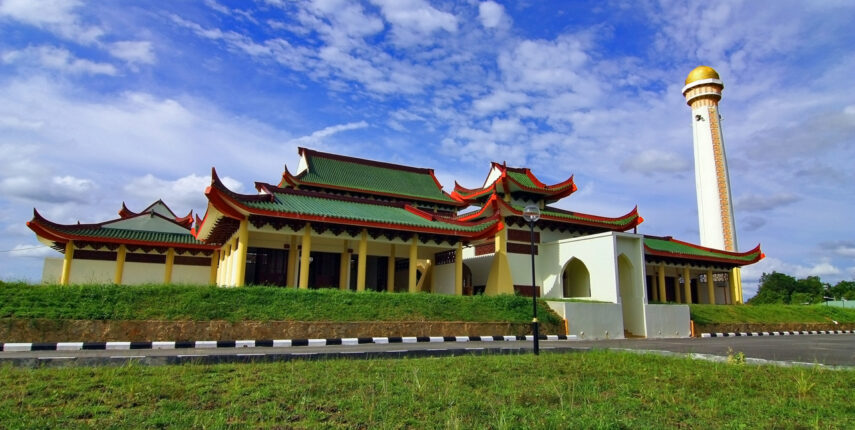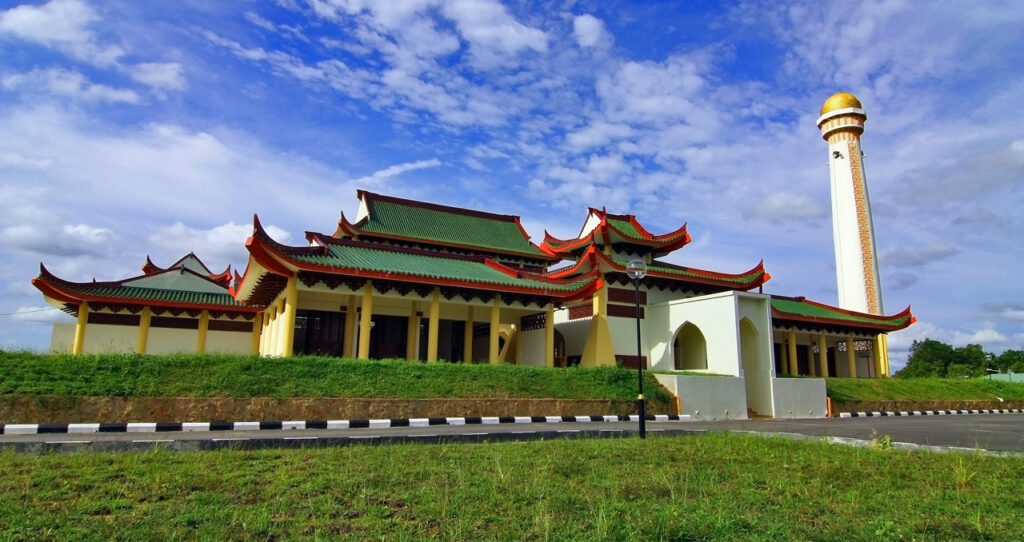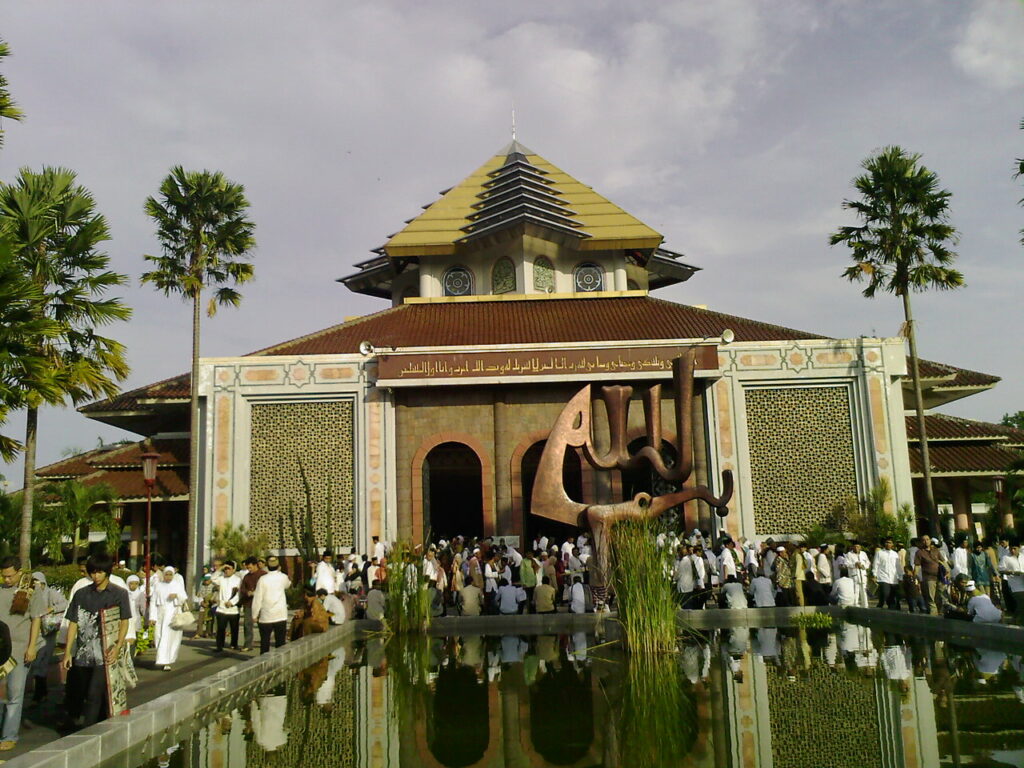
In his study of mosques in Europe, Roemer van Toorn noted that a mosque “is not just a house to honour God, but a place to come together, a collective space for the community. In short, a mosque as a space can provide a counterweight to the ‘public’ space of the individualized and consuming human being.”[1] I would extend this illuminating reflection further to argue that mosques in the Malay World are cosmopolitan spaces that enable different faiths, persuasions, ideologies, and temperaments to interact, collaborate, amalgamate, and appreciate the beauty of Islam and a sense of shared humanity. This is evidenced in the aesthetics of the mosque as well as the tolerance and cooperation between the devotees and communities frequenting these religious sites.
Mosques and Aesthetic Cosmopolitanism
That mosques in the region are architecturally cosmopolitan should not come as a surprise, given that there is no clearly defined template in Islam regarding mosque-building. Since the era of the Prophet Muhammad, Muslims have enjoyed the freedom to build mosques in a manner that blends the attraction of the natural surroundings with the imagination of the architects and builders.[2] Mosques in the Muslim Malay World have lived up to this tradition for many centuries. A majority of them embrace the multicultural, interreligious landscapes that surround them. The aesthetics bear evidence of a synthesis of varied forms, motifs, and sensory effects, or aesthetic cosmopolitanism. Aesthetic cosmopolitanism, as Nikos Papastergiadis rightly stressed, “does not simply refer to the aesthetic representations of cosmopolitanism, but to a cosmopolitan worldview that is produced through aesthetics.”[3]

Aesthetic cosmopolitanism in mosques can be seen in their architectural complexion. Many mosques in the region amalgamate the traditions of different religions while integrating a variety of styles and forms that are seemingly foreign to the Malay world. They display a high degree of heterogeneity in aesthetic expression because they have been built in ways that are sensitive to the multicultural spirit of the local Muslim societies that have unremittingly celebrated syncretism and diversity in their expressions of Islam.[4]
Aesthetic cosmopolitanism in mosques can be seen in their architectural complexion. Many mosques in the region amalgamate the traditions of different religions while integrating a variety of styles and forms that are seemingly foreign to the Malay world.
The best illustration of this is Beijing Mosque (Masjid Beijing, also known as the “Sultan Ismail Petra Silver Jubilee Mosque”) at Kota Bharu, Kelantan. Inaugurated in 2010, the mosque was envisioned as a “multicultural mosque that would reflect the diverse cultural influences in the Malay world – ranging from Chinese, Indian, Siamese, Malay and other sources.”[5] The mosque delivers even more than its creators had promised. At first glance, Beijing Mosque looks like any ordinary Chinese temple, featuring sloping roofs with upturned corners, a symmetrical floor plan, ornamental designs, and a spacious courtyard in the centre of the compound. In this way, Beijing Mosque is a near-replica of many mosques in China today. What is most striking about the mosque is that it is constructed in a Malay state purportedly known for its Malay-Islamic conservatism. The construction of Beijing Mosque shows that Muslim cosmopolitanism, in both architectural form and daily life, has a secure place in Kelantan.
Another layer of cosmopolitanism lies in the fusion of the modern and pre-modern, of vernacular as well as imported architectural traditions, projecting an image of both adaptation and synthesis. This fusion of forms and styles shows not only progress, but also the ability to preserve aspects of the Malay past that remain relevant in the reconstruction of Islam in a postcolonial and multicultural world. To quote Kishwar Rizvi: “Architecture serves as the physical embodiment of this mobility of meaning; the mosque is thus simultaneously a memorial to the past and an aspiration toward what is to come.”[6] Many Indonesian mosques feature both modern and traditional architectural influences. A local Indonesian historian described this transformation as a movement from ‘architectural homogeneity’ to ‘architectural hybridity’.[7] The University of Gadjah Mada Campus Mosque makes this apparent with its arabesque and modernist patterns interlaced with a roof and other structures that are similar to the historical Agung Demak Mosque.[8] Another example is the Grand Mosque of Central Java (Masjid Agung Jawa Tengah) that embodies a bricolage of local Javanese and modernist Middle Eastern forms.
Sacred Tolerance
Many mosques in the Malay world are located near temples, churches, synagogues or other sacred sites, a testimony to the harmony between worshippers of these different religions. I term this peaceful coexistence ‘sacred tolerance.’ It is a condition where devotees of religious sites maintain the uniqueness and sacredness of their places of worship without infringing upon the rights of those who do not subscribe to their beliefs. Sacred tolerance is evinced through the sharing of spaces within and outside specific sites. Adherents of different religions draw upon each other’s spaces to ensure that their rites and rituals can be practised easily and openly without inhibition. Furthermore, what makes sacred tolerance possible is the process of adaptation undertaken by Muslims and non-Muslims towards ensuring amity. Through the vehicle of mosques, Muslim cosmopolitans assist and support other communities of believers during festive occasions and, if necessary, during moments of crisis.
Sacred tolerance has been a feature in the history of Islam since mosques were instituted. The mosque began as an inclusive space where Muslims and even non-Muslims of all ages, sexes and backgrounds could come together for purposes of devotion, for social gatherings and for planning sessions of all sorts of activities including reconciliation. During the time of the Prophet Muhammad, there was a famous incident when a non-Muslim Bedouin came into the mosque and urinated within the compound. The Muslims were upset but the Prophet ordered them to not disturb the man, and instead, with his usual calmness, had water poured over the spot where the Bedouin had urinated. The Bedouin was impressed with the Prophet’s message of forbearance and wisdom.[9] Such actions set the example for Muslims in the generations to come. A mosque should be not only a domain where believers bring themselves closer to God and to their community, but a site where piety can be shared and appreciated by those who have yet to enter the fold of Islam.

The sacred tolerance of mosques is also made visible through the sharing of common spaces with other religious institutions. Such is the case with An-Naim Mosque in Sarawak, which was built less than a hundred metres from Good Shepherd Church.Mosques in the Malay world maintain this spirit of openness and tolerance. Annual religious functions and festivals, especially in Ramadan, have been moments when sacred tolerance were displayed. In July 2014, some seventy non-Muslim tourists joined Muslims in a breaking of the fast event at Putra Mosque in Kuala Lumpur. Co-organised by the Muslim Youth Movement of Malaysia and the Islamic Tourism Centre, the session included talks about Islam and the significance of fasting. The non-Muslims also joined in the congregational prayers to have a first-hand experience of Muslim devotions.[10] The breaking of the fast with non-Muslims has now become a yearly ritual in mosques across the region. Ministers and other prominent non-Muslim community leaders are often present during these events as part of their efforts to gain the support of the Muslim community.[11]
Another way in which mosques are open to non-Muslims is through impromptu visits. These mostly consist of walk-ins by non-Muslims who are in search of some form of assistance or who wish to know more about the mosque and its functions. Many mosques in the Malay world accommodate such impromptu visits. Raya Baiturrahman Mosque in Banda Aceh is one such mosque that allows non-Muslims to drop by at any moment they wish, provided the mosque is not closed for the night or for renovation. Certainly, the mosque is one of Aceh’s major post-tsunami tourist destinations.[12] Long dresses and pants are also prepared for non-Muslims to wear when they enter the mosque.
In the Malay world, non-Muslims can also enter mosques through institutionalised arrangements. These are structures that are established by mosques to attract non-Muslims to visit regularly and may come in two forms: outreach programmes and visual displays. Outreach programmes include dialogues, discussions and the sharing of perspectives on issues impacting Muslims and non-Muslims in general. In Singapore, outreach programmes have been one of the core activities of mosques since the September 11 attacks. At An-Nahdah Mosque in Singapore, for example, the Harmony Centre was established in October 2006. It is basically a space within the mosque where visitors can learn about Islam and Muslim civilisations. Interfaith dialogues are also organised between the major religious groups in the country, which include Christianity, Buddhism, Hinduism, Sikhism and Baha’ism. The implicit aim of this centre, as Eugene Tan observes, is to encourage Muslim youths to steer away from radical ideologies.[13] More than that, underlying many of the Harmony Centre’s activities is the will on the part of the Muslim community to combat Islamophobia and misconceptions about the religion and its adherents.
The sacred tolerance of mosques is also made visible through the sharing of common spaces with other religious institutions. Such is the case with An-Naim Mosque in Sarawak, which was built less than a hundred metres from Good Shepherd Church.
The sacred tolerance of mosques is also made visible through the sharing of common spaces with other religious institutions. Such is the case with An-Naim Mosque in Sarawak, which was built less than a hundred metres from Good Shepherd Church. The mosque and the church share their car parks on specific days. The church allows Muslim congregants to use its car park every Friday for their weekly prayers. The mosque, in turn, opens its car park for churchgoers on Sunday. Both mosque and church worshippers have been breaking fasts together annually during the month of Ramadan for the past fifty years. The church reciprocates in kind by inviting Muslims to the church for dinner during Christmas. Commenting on such mutual reciprocity, the imam of An-Naim Mosque, Imam Mohd Zulkifli, said, “It has become a way of life for us to share car parks and meet for gatherings. To us, Muslims and Christians are one big family.”[14]
Nowhere is such cosmopolitan temperance more visible than at Jalan Gatot Subroto, Surakarta, in Indonesia. Al-Hikmah Mosque shares not only the same space as Joyodiningratan Church, but also the same mailing address. When asked how the church and the mosque could coexist in such a manner, a local pastor remarked, “we [the church and the mosque] have to live together or learn to live together as we are born to be together…we are only two meters apart…we have made every effort to establish a mutually beneficial partnership.”[15] He admitted that there have been episodes of tension, but, by and large, both religious groups get along well together. Their main instrument for sustaining a close relationship is through acts of reciprocity and tolerance.
Conclusion
Mosques in the Malay World have long functioned as cosmopolitan spaces where Muslims can connect with the divine and intermingle with their co-religionists, and where non-Muslims can equally benefit from the amenities and services offered by the mosques to the community at large.
Mosques in the Malay World have long functioned as cosmopolitan spaces where Muslims can connect with the divine and intermingle with their co-religionists, and where non-Muslims can equally benefit from the amenities and services offered by the mosques to the community at large. However, the mosques’ function as cosmopolitan spaces goes even further. Cosmopolitanism can also be found in the mosques’ outward manifestations, in that they are designed in styles and forms that make them appealing to the eyes of believers and non-believers alike. These designs have drawn upon the traditions of East and West, as well as a combination of modern, local, and global ideas about the architecture of iconic buildings.
It is astonishing, therefore, that, even after more than seven centuries of instrumental existence, mosques in Muslim the Malay World have escaped the attention of researchers in their analyses of cosmopolitan sites. A plausible reason for this has to do with the perception that mosques are generally exclusive to Muslims and that conservatives and fundamentalists have jealously guarded this exclusivity.[16] While this perception of mosques may be true in exceptional cases, it does not reflect the general texture of social relations within the mosques, or even the external appearances of these places of worship. Mosques are cosmopolitan spaces and scrutinising them in this manner enables us to reconsider these and other sacred places in Islam as sites where both Muslims and non-Muslims can derive much personal and spiritual inspiration.
Dr. Khairudin Aljunied (PhD SOAS, London) is a tenured Associate Professor at the National University of Singapore. He is concurrently a Senior Fellow (formerly and Professor as well as Malaysia Chair of Islam in Southeast Asia at the Alwaleed Centre for Muslim-Christian Understanding, Georgetown University). A recognized specialist in the field of intellectual history, Khairudin Aljunied’s research focuses on the connections between Southeast Asia and Global Islam. He is the author and editor of thirteen books and more than thirty internationally refereed articles. In 2024, he is listed as one of the 500 influential Muslims in the world in 2024: https://themuslim500.com
[1] Roemer van Toorn, ‘Counteracting the Clash of Cultures: Mosque Architecture as an Emancipating Factory’, in Ergün Erkoçu and Cihan Buǧdaci, The Mosque: Political, Architectural and Social Transformations (Rotterdam: Nai Publishers, 2009), p. 112.
[2] Seyyed Hossein Nasr, Islam: Religion, History and Civilization (San Francisco: Harper, 2003), p. 94.
[3] Nikos Papastergiadis, Cosmopolitanism and Culture (Cambridge: Polity Press, 2012), p. 90.
[4] David Snellgrove, ‘Syncretism as a Main Feature of Indonesian Culture, As Seen by One More Used to Another Kind of Civilization’, Indonesia Circle, 20, 56 (1991), pp. 24–48.
[5] Farish A. Noor, ‘Kelantan’s Multicultural Mosque Laudable’, Malaysiakini, 8 November 2000.
[6] Rizvi, The Transnational Mosque, p. 4.
[7] Wiryomartono, ‘Historical View’, p. 43.
[8] Pudji Pratitis Wismantara, ‘The Dynamics of the Form of Nusantara Mosque: Architectural Homogeneity Pmbol of pa, ‘Cheng Ho Mosque, a hanld seem to be the better one to have. same place, i.e. the annual report, but this link showvis a vis Architectural Hybridity’, Journal of Islamic Architecture, 2, 1 (2012), pp. 21–7.
[9] Muhammad bin Ismail al-Bukhari, Translation of the Meanings of ‘Sahih al-Bukhari’, translated by Muhammad Muhsin Khan (Chicago: Kazi Publications, 1997), p. 41.
[10] Zainarida Emilia Zaidi, ‘70 pelancong bukan Islam sertai majlis berbuka puasa’, My Putrajaya News, 17 July 2014, <http://myputrajayanews.com/v2/70-pelancong-bukan-islam-sertai-majlis-berbuka-puasa/> (last accessed 8 February 2016).
[11] Lim Yan Liang, ‘Ministers Join 800 Breaking Fast at Mosque’, The Straits Times, 23 June 2015.
[12] Sue Kenny et al., ‘Deconstructing Aceh’s Reconstruction’, in Sue Kenny, Matthew Clarke, Ismet Fanany and Damien Kingsbury (eds), Post-Disaster Reconstruction: Lessons from Aceh (London: Earthscan, 2010), p. 13.
[13] Eugene K. B. Tan, ‘Norming “Moderation” in an “Iconic Target”: Public Policy and the Regulation of Anxieties in Singapore’, Terrorism and Political Violence, 19, 4 (2007), p. 453.
[14] Foreign Desk, ‘Muslims, Christians Hold Joint Break Fast Event at Adjoining Mosque, Church in Sarawak’s Miri’, The Straits Times, 4 July 2015.
[15] Quoted in Myengkyo Seo, State Management of Religion in Indonesia (London: Routledge, 2013), p. 80.
[16] François Raillon, ‘The Return of the Pancasila: Secular vs Islamic Norms, Another Look at the Struggle for State Dominance in Indonesia’, Michel Picard and Rémy Madinier (eds), The Politics of Religion in Indonesia: Syncretism, Orthodoxy, and Religious Contention in Java and Bali (London: Routledge, 2011), p. 98.

